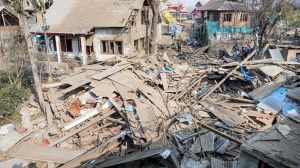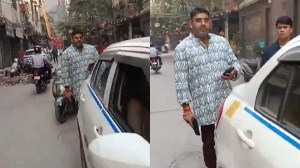Greenpeace activists shut down effluent treatment plant at Vapi
VAPI, OCT 20: In what seems the beginning of their battle against the Gujarat Government, Greenpeace activists on Thursday forcibly shut d...

VAPI, OCT 20: In what seems the beginning of their battle against the Gujarat Government, Greenpeace activists on Thursday forcibly shut down the common effluent treatment plant (CETP) here by removing the valves of its pump house, alleging that it continues to discharge poisonous water into the Damanganga river.
“If the State government avoids taking necessary action to ensure that pure water is discharged from CEPT into the Damanganga river, we will request the World Bank officials to stop its infrastructural aid”, Nityanand Jayaraman of Greenpeace said.
Jayaraman said that Greenpeace activists would make the request to top officials of the donor agency when they would be visiting Gandhinagar in November to meet Chief Minister Keshubhai Patel. He clarified that their protest today hadn’t caused any damage to CETP.
According to figures available with the Vapi Industries Association, the effluent generated by around 2,000 industrial units in Vapi is treated in CETP. About 750 of these are chemical units. “The so-called treated effluent discharged by CETP contains dangerous quantities of poisons, including toxic metals such as lead, cadmium, chromium, copper and even mercury, as also highly poisonous hexachlorobenzene (HCB),” Jayaraman said, quoting an analysis report.
Greenpeace activists from Bombay and Vadodara, as also from 15 countries, along with about 200 residents from nearby villages of Daman, Sarigam and Kolak, gathered at the CETP campus around 10.30 am. BJP MP from Daman, Manubhai Tandel, was also there. The foreigners had come from UK, USA, Australia, the Netherlands, New Zealand, Thailand, China, the Phillipines, Hongkong and Japan. They held banners condemning the increasing levels of pollution in South Gujarat region.
The activists first marched towards the CETP administrative office. Some of them went inside to hand over their charter of demands to officials, while another group, mainly foreigners, rushed to the CETP’s pump house, put on gas-masks, and chained themselves to the valves.
Outside, a meeting began where Kantibhai, a villager from Kolak, lamented that all 5,000 fishermen in the village had to take up odd jobs because untreated effluents, carried by Kolak river, had killed the fish along the sea coast. He also said that cancer, TB, and respiratory and other diseases were common in his village.
Prakash Arekar, sarpanch of Sarigam, said the effluents had polluted groundwater. “There are about 45 chemical units in Sarigam and, in the absence of proper disposal, the effluent percolates into the underground water”, Arekar said.
While the speeches went on, the activists inside the pump house kept themselves chained to valves. Around 5 pm, they removed the valves, shutting down the plant. “Our activists removed the valves after the authorities refused to accept our demand to ensure that CETP functioned properly,” Jayaraman said.
He said that Greenpeace International had demanded that the State government impose a moratorium on setting up of chemical units in Gujarat. “The entire golden corridor, which is cancer corridor, starting from Ahmedabad to Vapi, has been badly affected by the industrial pollution,” Jayaraman said, adding that lots of arable land had been rendered barren.
A A Dolti, regional officer of the Gujarat Pollution Control Board, however, described as baseless the Greenpeace contention that CETP-treated effluents contained poisonous metals. “We have documents to prove that the treated effluent contains chemical substances within permissible limits”, Dolti said.




- 01
- 02
- 03
- 04
- 05



























